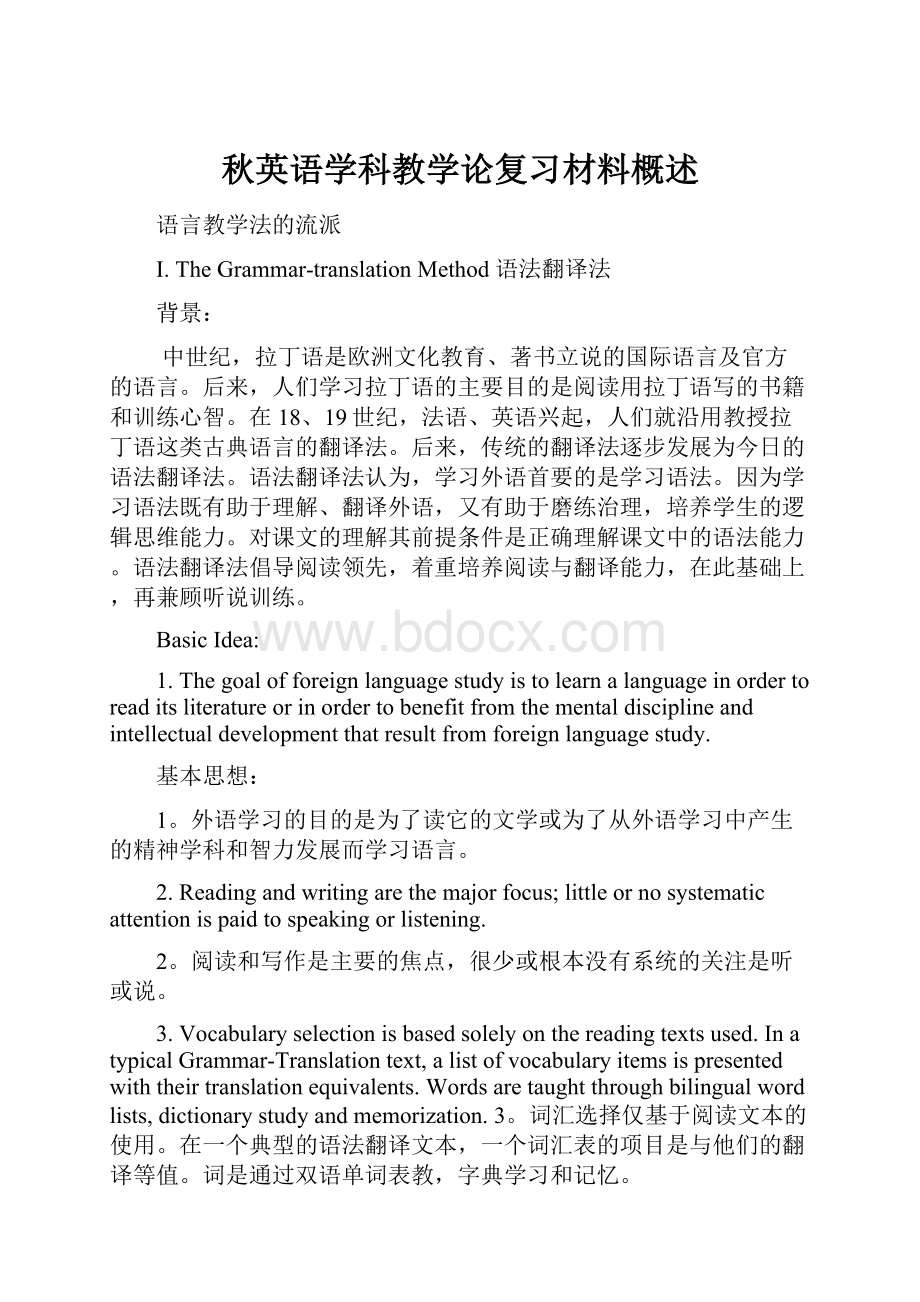秋英语学科教学论复习材料概述.docx
《秋英语学科教学论复习材料概述.docx》由会员分享,可在线阅读,更多相关《秋英语学科教学论复习材料概述.docx(30页珍藏版)》请在冰豆网上搜索。

秋英语学科教学论复习材料概述
语言教学法的流派
I.TheGrammar-translationMethod语法翻译法
背景:
中世纪,拉丁语是欧洲文化教育、著书立说的国际语言及官方的语言。
后来,人们学习拉丁语的主要目的是阅读用拉丁语写的书籍和训练心智。
在18、19世纪,法语、英语兴起,人们就沿用教授拉丁语这类古典语言的翻译法。
后来,传统的翻译法逐步发展为今日的语法翻译法。
语法翻译法认为,学习外语首要的是学习语法。
因为学习语法既有助于理解、翻译外语,又有助于磨练治理,培养学生的逻辑思维能力。
对课文的理解其前提条件是正确理解课文中的语法能力。
语法翻译法倡导阅读领先,着重培养阅读与翻译能力,在此基础上,再兼顾听说训练。
BasicIdea:
1.Thegoalofforeignlanguagestudyistolearnalanguageinordertoreaditsliteratureorinordertobenefitfromthementaldisciplineandintellectualdevelopmentthatresultfromforeignlanguagestudy.
基本思想:
1。
外语学习的目的是为了读它的文学或为了从外语学习中产生的精神学科和智力发展而学习语言。
2.Readingandwritingarethemajorfocus;littleornosystematicattentionispaidtospeakingorlistening.
2。
阅读和写作是主要的焦点,很少或根本没有系统的关注是听或说。
3.Vocabularyselectionisbasedsolelyonthereadingtextsused.InatypicalGrammar-Translationtext,alistofvocabularyitemsispresentedwiththeirtranslationequivalents.Wordsaretaughtthroughbilingualwordlists,dictionarystudyandmemorization.3。
词汇选择仅基于阅读文本的使用。
在一个典型的语法翻译文本,一个词汇表的项目是与他们的翻译等值。
词是通过双语单词表教,字典学习和记忆。
4.Thesentenceisthebasicunitofteachingandlanguagepractice.Muchofthelessonisdevotedtotranslatingsentencesintoandoutofthetargetlanguage,anditisthisfocusonthesentencethatisadistinctivefeatureofthemethod.4。
句子是教学和语言实践的基本单位。
本课的重点是把句子分成目标语言,这是一个独特的特征的方法,它是这个重点。
5.Grammarrulesaretaughtdirectlybytheteacherwithexceptiontoeachrulenoted.Thentheruesarepracticedthroughtranslationexercises.
5。
语法规则是由老师直接讲授的,每个规则都有例外。
然后,所实行的是通过翻译练习。
6.Thestudent’snativelanguageisthemediumofinstruction.Itisusedtoexplainnewitemsandtoenablecomparisonstobemadebetweentheforeignlanguageandthestudent’snativelanguage.6。
学生的母语是教学的培养基。
它是用来解释新的项目,并使比较之间的外国语言和学生的母语。
以语法和词汇为主要内容,以翻译和语法讲解为主要手段,以母语为主要载体,以文字为依托工具,以系统培养学生的外语理解和翻译能力为主要目标。
II.TheAudio-lingualMethod听说法
背景:
二战时期,美国不重视外语教学,当因为战争需要而需派送大批青年到有关国家时,就面临快速培训青年掌握基本的外语的需求。
当时对这些青年的培训都将结构主义语言学理论付诸教学实践,积累了教学经验。
后来,这些经验总结提升,形成了成熟的听说法语言教学。
TheoreticalFoundation:
1.StructuralViewofLanguage结构主义语言学
Thestructuralviewoflanguageseeslanguageasalinguisticsystemmadeupofvarioussubsystems:
thesoundsystem(phonology);thediscreteunitsofmeaningproducedbysoundcombinations(morphology),andthesystemofcombiningunitsofmeaningforcommunication(syntax).Eachlanguagehasafinitenumberofsuchstructuralitems.
理论基础:
1。
语言结构主义语言学结构视图
语言结构观把语言视为一种由不同子系统组成的语言系统:
语音系统(音系);由声音组合产生的离散单元(形态),以及与之相结合的通信单元(语法)系统。
每一种语言都有有限数量的此类结构项目。
Tolearnalanguagemeanstolearnthesestructuralitemssoastobeabletounderstandproducelanguage.Whenthisstructuralviewoflanguagewascombinedwiththestimulus-responseprinciplesofbehaviouristicpsychology,theaudiolingualapproachtolanguageleaningemerged..学习一种语言意味着学习这些结构项目,以便能够理解产生语言。
当这种语言结构的观点是结合行为心理学的刺激反应原理,对语言学习产生..听说法
2.BehavioristTheory行为主义心理学
Learningisaprocessofhabitformation.Stimuli,response,reinforcement.Learningaforeignlanguagemeansstudentsshoulddolotsofrepletion.2。
行为主义理论行为主义心理学
学习是一种习惯形成的过程。
刺激,反应,强化。
学习一门外语就意味着学生要做大量的实。
BasicIdea:
1.Thegeneralobjectiveistoenablethestudentstousethetargetlanguagecommunicatively.Intheearlystages,thefocusisonoralskills,withgraduallinkstootherskillsaslearningdevelops.Theprimarystressislaidonoralproficiency,whichmeansthestudentsshouldachieveaccuratepronunciationandcorrectgrammar.Verylittleuseofthemothertonguebyteachersispermitted.基本思想:
1。
总的目标是使学生所使用的目标语言。
在早期阶段,重点是口头技能,与其他技能的逐渐联系,学习发展。
主要的压力是口头上的,这意味着学生要达到准确的发音和正确的语法。
很少使用母语的教师是允许的。
2.Thereislittleornogrammaticalexplanation.Grammaristaughtbyinductiveanalogy2。
很少或根本没有语法解释。
语法是用归纳法进行的。
ActivityType:
1.Repetitiondrill(重复练习):
RepetitionDrillisoftenusedtoteachthelinesofthedialogue.Studentsareaskedtorepeattheteacher’smodelasaccuratelyandasquicklyaspossible.重复练习(重复练习):
重复训练经常用来教台词。
学生被要求尽可能准确地重复老师的模型。
2.Simplesubstitutiondrill(简单替换练习):
Thestudentsrepeatthelinefromthedialoguewhichtheteacherhasgiventhem,substitutingthecueintothelineinitsproperplace.
简单的替换练习(简单替换练习):
学生从老师给他们的对话中重复了这条线,在适当的地方用球杆代替了这条线。
3.ProgressiveDrill(渐进替换练习):
Itissimilartothesimplesubstitutiondrill.Thedifferenceisthattheteachergivescuephrases,oneatatime,thatfitintodifferentslotsinthedialogueline.
4.TransformationDrill(转换练习):
Theteachergivesstudentsacertainkindofsentence,andaffirmativesentenceforexample.Studentsareaskedtotransformthissentenceintoanegativeone.
5.Question-and-answerDrill(问答练习):
Question-and-answerdrillhelpsstudentspracticewithansweringquestions.
6.ExpansionDrill(扩展句子练习):
Thisdrillhelpsstudentstoproducelongersentencesbitbybit,graduallyachievingfluency.
7.ClausecombinationDrill(合并句子练习):
Studentslearntocombinetwosimplesentencesintoacomplexone.
8.Backwardbuild-upDrill(逆向读句练习):
Thisdrillisusedwhenalonglineofadialogueisgivingstudentstrouble.Theteacherbreaksdownthelineintoseveralparts.Thestudentsrepeatapartofthesentence,usuallythelastphraseoftheline.Then,followingtheteacher’scue,thestudentsexpandwhattheyarerepeatingpartbypartuntiltheyareabletorepeattheentireline.
9.ChainDrill(连锁练习):
Students,one-by-one,askandanswerquestionsofeachother.Theteacherbeginsthechainbyaskinghimaquestion.Thatstudentresponds,thenturnstothestudentsittingnexttohim.Achaindrillallowssomecontrolledcommunication,eventhroughitislimited.
10.Mini-dialogue(小对话):
Thisdrillhelpsstudentstolearntomakeanappropriateresponseorreplytoagivenutterance.Studentsaretoldinadvancetorespond.
11.Completion(完成句子练习):
Studentshearanutterancethatiscompleteexpectforoneword,thenrepeattheutteranceincompletedform.
12.Useofminimalpairs(最小成对练习,又称语音辨别练习):
Theteacherworkswithpairsofwordswhichdifferinonlyonesound;studentsarefirstaskedtofindthedifferencebetweenthetwowordsandlatertosaythetwowords.
III.TheCognitiveApproach认知法
TheoreticalFoundation:
Cognitiveviewoflanguagelearning认知语言学习观
Languageisnotaformofbehaviour.Itisanintricate(complicated)rule-basedsystem.(Languageisrule-governed.)Thereareafinitenumberofgrammaticalrulesinthesystemandwithknowledgeoftheserulesaninfinitenumberofsentencescanbeproduced.(Languageisgenerative.)Childrenarebornwithaspecialabilitytodiscoverforthemselvestheunderlyingrulesofalanguagesystem.Chomskyreferredtotheinnatelanguageabilityaslanguageacquisitiondevice(LAD).Itisapostulated“organ”ofthebrainthatissupposedtofunctionasainborndeviceforlanguageacquisition.
Oneinfluentialideaisthatstudentsshouldbeallowedtocreatetheirownsentencesbasedontheirunderstandingofcertainrules.ThisideaisclearlyinoppositiontotheAudio-LingualMethod.
CognitivePsychology认知心理学
布鲁纳提出的“发现式教学法”:
教学过程不应该由教师将规则和原理灌输给学生,而是要让学生在教师的引导下,通过“自己发现”进行逻辑思维活动,对所学材料或对象进行观察、分析和归纳。
这种发现式学习有助于激发学生的学习兴趣和学习动机,进而培养他们独立分析问题和解决问题的能力。
奥苏贝尔提出“有意义学习”:
学习有两种类型。
一是机械性学习,学生对所学的知识缺乏了解,纯粹用死记硬背的方式去记忆。
这种学习短期内有效,时间一长就失灵了。
有意义学习则是一种认知学习,学生在理解所学基本概念和规则的基础上学习,另外还了解知识结构之间的内在联系。
BasicIdea:
1.Thegoalis:
Todevelopinthestudentsthenative-likecompetence;Todevelopintuitivethinkinginlearners;Todevelopstrategiesoflanguageuse;Toenablethestudentstolearnfromerrors.
2.以学习者为中心Itgivesimportanttothelearner’sactivepartintheprocessofusingandlearningalanguage,particularlyinthelearningofgrammaticalrules.
3.对错误进行分析和疏导。
Mistakesareunavoidableinthecreativeuseoflanguage.Students’mistakesareanecessaryandnaturalphenomenon,andafeatureofthelanguageasheprogressesinthesecondlanguage.Whattheteachershoulddoistoanalyzethemistakessothattheycouldfindthecauseanddosomeremedialworkaccordingly.
4.在理解语言知识和规则的基础上练习外语,强调有意义的学习和有意义的操练。
5.语法的讲解,将学生总结规则和教师的讲解规则相结合。
6.主要听说读写齐头并进,同时学习。
IV.CommunicativeLanguageTeaching交际法
相关理论:
Functionalviewoflanguage功能主义语言观
Thefunctionalviewnotonlyseeslanguageasalinguisticsystembutalsoameansfordoingthings.Mostofourday-to-daylanguageuseinvolvesfunctionalactivities:
offering,suggesting,advising,apologizing,etc.Therefore,learnerslearnalanguageinordertobeabletodothingswithit.
Inordertoperformfunctions,learnersneedtoknowhowtocombinethegrammaticalrulesandthevocabularytoexpressnotionsthatperformthefunctions.
Interactionalviewoflanguage交互性语言观
Theinteractionalviewconsiderslanguagetobeacommunicativetool,whosemainuseistobuildupandmaintainsocialrelationsbetweenpeople.Therefore,learnersnotonlyneedtoknowthegrammarandvocabularyofthelanguagebutasimportantlytheyneedtoknowtherulesforusingtheminawholerangeofcommunicativecontexts.
交际能力CommunicativeCompetence
1.LinguisticCompetence:
Linguisticcompetenceconcernswithknowledgeofthelanguageitself,itsformandmeaning.Morespecifically,itinvolvesspelling,pronunciation,vocabulary,wordformation,grammaticalstructure,sentencestructure,andsemantics.
语言能力是指理解语言本身,语言形式及其意义的能力。
语言能力包含了拼写、发音、词汇、构词、语法、句型和语义等方面的能力。
语言能力是交际能力的基石,一个不可缺少的组成部份。
2.PragmaticCompetence
Pragmaticcompetenceisconcernedwiththeappropriateuseofthelanguageinsocialcontext.Thatistosay,thechoiceofthevocabularyandstructuredependsonthesetting,therelativestatusofthespeakers,andtheirrelationships.
语用能力指学习者在特定的语境中针对特定的对象知道如何合适清晰地表达自己的意图的能力。
“何时说,何时不说,和谁,什么时间,什么地点,以什么方式说些什么”。
3.DiscourseCompetence篇章能力
Discoursecompetencereferstoone’sabilitytocreatecoherentwrittentextorconversationand